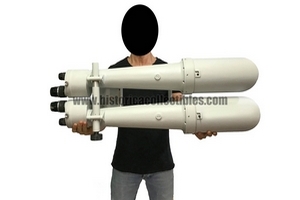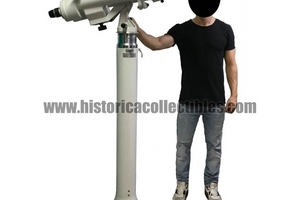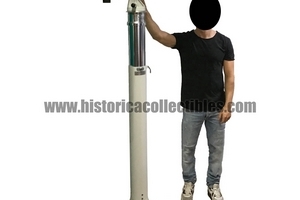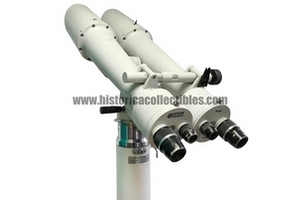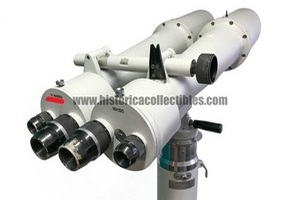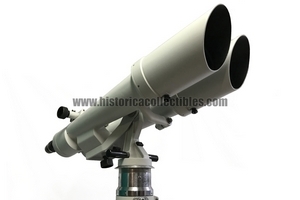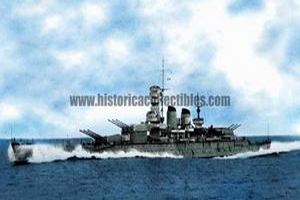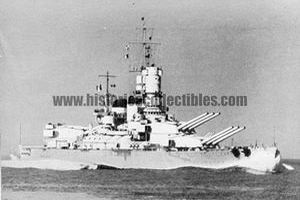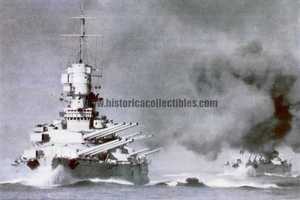Binoculars Officine Galileo, 18x 35x 120, Littorio Class Battleship, 1941
Large naval optical-mechanical complex, designed and built by Officine Galileo of Florence in 1941, to be used for the Royal Battleship "Littorio", part of the 1st Naval Squadron and Flagship of the 9th Armored Division based in Taranto.
Thanks to the existence of an official letter dated 1975, written by the Director of the Officine Galileo of Florence in response to a formal question posed to him regarding this 18x 35x 120 mm optical instrument and its relative support, it was possible to know the origin of its history, its client, the location and the quantity produced, which appears to have been made in only 2 (two) examples equipped with identical structural, optical and mechanical characteristics.
With good reason, we know how important the historical value of this precious information is, furthermore we are not currently aware of the reasons why the Command in Chief of the Ionian and Adriatic Maritime Department of Taranto decided to commission in December 1940 these 2 large optical complexes, despite the ship having entered the operational line only a few months earlier.
The thesis can be reasonably accepted, according to which, following the bombing of Taranto which occurred on the night between 11 and 12 November 1940, by a formation of English planes in which the Royal Ship Littorio was seriously damaged, the The High Command of the Navy, taking advantage of the period necessary to restore the damage suffered (which lasted over six months), decided to equip it with two extraordinary binocular complexes which had an excellent level of optical performance, thus placing the observers in a position to immediately ensure, the sighting of enemy ships and aircraft located even at considerable distances: in fact, until that moment, binocular optical elements equipped with such characteristics, assigned to the ships of the Royal Italian Navy, did not exist.
Only two examples were made, so much so that Admiral Inigo Campioni, Commander of the Italian Naval Squadron, immediately expressed his desire to have them ready on the Flagship, favoring the operational efficiency of the entire Squadron with their placement on board.
This hypothesis takes shape as it has been widely ascertained that in the same period it happened on board the R.N. Littorio, also the installation of a localization apparatus (rudimentary radar), which was shortly removed because it was considered totally inefficient. However, with the preparation of these two optical groups and the pseudo "radar", the High Command of the Royal Navy hoped to have provided, even if to a minimal extent, a valid solution capable of avoiding, at least during the day, sudden, potentially devastating aircraft or ship attacks.
The large optical unit, built in solid aluminum alloy, is equipped with plates with rotating eyepieces capable of magnifying images by 18x and 35x, its objective lenses are 120 mm. Furthermore, the rotating system of the eyepiece holders allows it to be used by two observers simultaneously. The platform used to support it, together with the tilting element on which it is anchored, is also made of aluminum alloy and is equipped with two steel columns (one sliding into the other) inside which, a mechanical device with pulley transmission also called "periscope elevation", it allows the observer to adapt the optical assembly to variable heights best suited to use. Finally, a special flange, located on the external column, allows it to be locked at the desired height.
The absolute certainty that this large optical-mechanical group, together with the other mentioned in the letter by the Director of Officine Galileo, were the only two examples designed, built and installed on the Regia Nave Littorio, during the 2nd worl war, is clearly supported by the presence of the original documentation of the time.
In fact, as reported in the letter from the Director of the Officine Galileo, some structural technical observations made by the Officine Galileo technicians on board the Royal Italian Ship Littorio were considered for their construction (they were specially designed).
With the worsening of the war situation, the beginning of the defeat of fascism starting from 1943 and no less the various bombings by the allies, suffered by all the Galileo and Affiliated factories, especially those of Battaglia Terme, where the Officine foundries were located Galileo and many other machines useful for the creation of optics which were destroyed, did not further allow mass production, albeit limited, of these extraordinary optical groups.
History of Officine Galileo:
The foundation of the company dates back to 1862, by the astronomer and instrument maker Giovanni Battista Amici, a well-known scientist of the time, "skilled optician and mechanic", who had arrived in Florence in 1831 called by the Grand Duke Leopold II with the task of directing “La Specola” and the Physics Museum.
Friends to overcome the difficulties and costs of supplying scientific instruments, objects for which, given the poor industrial structure, the Grand Duchy was heavily dependent on imports, decided to start a workshop which in 1864 would take the name of "Officina Galileo" . Upon Amici's death in 1863 the workshop went through a period of crisis, which was overcome thanks to Amici's successor, the Pisan scientist Giovanni Battista Donati with the help of Angelo Vegni, another scientist.
After Donati's death in 1873, production expanded to electrical and lighting instruments. At that time, forty specialized workers were employed. Initially the laboratories were housed in the buildings of the Tuscan Technical Institute, then in 1870 they were moved to a new location near the Cure barrier on the then outskirts of Florence. The excellent instruments produced were adopted by the observatories of Arcetri, Asiago and Merate.
In 1875 with the purchase of the land on which the workshop stands, A. Vegni remained the sole owner of the workshop, but with his death in 1883 the Agricultural Institute inherited the Galileo Workshop and due to the lack of interest of the Agricultural Institute, Galileo is going through a period of profound economic crisis.
In 1895 a limited partnership was established, with the general partner being the engineer Giulio Martinez and the limited partner the Vegni Institute. The new company which maintained the name Officina Galileo began its activity on 1 July 1896 and began the production of optical instruments for the Royal Navy, in particular periscopes and rangefinders, a production which would continue throughout the Second World War.
In 1899 the Vegni Agricultural Institute withdrew from the company by selling its share.
On 17 March 1907 the general meeting of shareholders resolved to dissolve the Company and on the following 4 April the Officine Galileo joint-stock company was established. One of the two vice presidents of the Board of Directors was the scientist Guglielmo Marconi. In July of the same year, a plot of land was purchased in Rifredi and in May 1909 the transfer of the machinery to the Rifredi factory began where on 27 September of the same year the regular activity of the Officine Galileo began.
Between 1909 and 1911, the first Meccano textile production pavilion was built in Rifredi called "M" and consists of a first nucleus, having a structural typology of iron and glass spans with cast iron pillars, and a subsequent expansion in reinforced concrete, made between 1914 and 1918.
The latest expansions, carried out close to the First World War, concerned the accommodation for the workers and the canteen rooms. Once the crisis due to the First World War was overcome, the period of greatest splendor for the "Galileo" was between the two wars thanks to the large orders for the Royal Navy.
During the war period, over 8,000 people were employed in the Rifredi plant and the antenna of the first radars installed on Italian ships was created by Officine Galileo, as were the fire control units and the stereoscopic rangefinders. Once the war was over, the company found itself heavily penalised, with many machinery having been transferred to Northern Italy at the end of 1943, the Allies having heavily bombed the entire Rifredi neighbourhood, with entire departments of the workshop destroyed and the Germans in retreat which had blown up a good part of the remaining machinery.
After the war, production activity was authorized by the Allies only for the production of non-strategic products. However, the problem of converting activities from military to civilian was faced and resolved thanks to the experiences acquired in a large number of sectors, so in 1945 a development plan was prepared which favored civilian production and, once again, the sectors of activity were very vast, ranging from electrical instrumentation to high vacuum equipment and in particular the production of machines and looms for the textile industry was developed also due to the presence of nearby Prato which at the end of the war had over 40% of the machinery and textile factories destroyed.
Currently, with the transfer of ownership to Finmeccanica, further major changes are taking place, as it is decided that the Company's core business must be concentrated in the military and space sectors, so other sectors, in which "Officine Galileo" was the world leader, are being sold.

